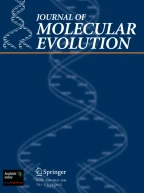Summary
The efficiency of obtaining the correct tree by the maximum likelihood method (Felsenstein 1981) for inferring trees from DNA sequence data was compared with trees obtained by distance methods. It was shown that the maximum likelihood method is superior to distance methods in the efficiency particularly when the evolutionary rate differs among lineages.
Similar content being viewed by others
References
Felsenstein J (1978) Cases in which parsimony and compatibility methods will be positively misleading. Syst Zool 27: 401–410
Felsenstein J (1981) Evolutionary trees from DNA sequences: a maximum likelihood approach. J Mol Evol 17:368–376
Fukami-Kobayashi K, Tateno Y (1991) Robustness of maximum likelihood tree estimation against different patterns of base substitutions. J Mol Evol 32:79–91
Hasegawa M, Yano T (1984) Maximum likelihood method of phylogenetic inference from DNA sequence data. Bull Biomet Soc Japan 5:1–7
Jukes TH, Cantor CR (1969) Evolution of protein molecules. In: Munro HN (ed) Mammalian protein metabolism, vol III. Academic Press, New York, pp 21–132
Saitou N (1988) Property and efficiency of the maximum likelihood method for molecular phylogeny. J Mol Evol 27:261–273
Saitou N, Imanishi T (1989) Relative efficiencies of the Fitch-Margoliash, maximum-parsimony, maximum-likelihood, minimum-evolution, and neighbor-joining methods of phylogenetic tree construction in obtaining the correct tree. Mol Biol Evol 6:514–525
Saitou N, Nei M (1987) The neighbor-joining method: a new method for reconstructing phylogenetic trees. Mol Biol Evol 4:406–425
Sourdis J, Nei M (1988) Relative efficiencies of the maximum parsimony and distance-matrix methods in obtaining the correct phylogenetic tree. Mol Biol Evol 5:298–311
Author information
Authors and Affiliations
Rights and permissions
About this article
Cite this article
Hasegawa, M., Kishino, H. & Saitou, N. On the maximum likelihood method in molecular phylogenetics. J Mol Evol 32, 443–445 (1991). https://doi.org/10.1007/BF02101285
Received:
Revised:
Issue Date:
DOI: https://doi.org/10.1007/BF02101285
